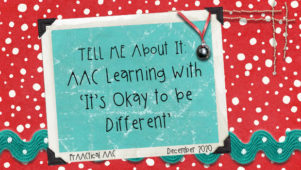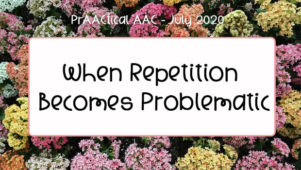5 AAC Strategies & The “Use It or Lose It” Philosophy

 School has begun for almost everyone. Some classes have been in session for a while and routines have been formed, learning is taking place, behaviors have settled down. Now comes what can seem like the hard part: Keeping up with and expanding the strategies that helped students become successful. Instead of trying to fade AAC displays/devices and visual supports, stick with the basics and expand how they can be used. Because if you don’t use it, you may lose it. So:
School has begun for almost everyone. Some classes have been in session for a while and routines have been formed, learning is taking place, behaviors have settled down. Now comes what can seem like the hard part: Keeping up with and expanding the strategies that helped students become successful. Instead of trying to fade AAC displays/devices and visual supports, stick with the basics and expand how they can be used. Because if you don’t use it, you may lose it. So:
 Keep up with:
Keep up with:
- Visual Schedules– monthly, daily, and mini. Even if students know the schedule, continue to use it. Most of us would not like ‘losing’ our day planner or ‘to do’ lists even though we know our schedules.
- Aided Language Input
- First- Then Visual Support
- Visual Boundaries
- Access to a AAC Display/Device– And the display or device is with the student All the time, everywhere, charged, working, and with appropriate core and fringe vocabulary.
- Use the visual schedules to help talk about past event or with rating scales for rating preferences from likes/dislikes to hard/easy or preferences to do it again. Or use the visual schedule to teach core vocabulary. Have the student prepare their own schedule, make the schedule more portable. Create a schedule system that can be used at older ages also. Don’t forget to teach ‘change of schedule’.
- Aided Language Input and add other language facilitation strategies– Use expansions, aided language input could move from 1-2 words to longer and/or more complex sentences. For example, if you were AAC modeling “want truck”, expand to “want big truck please”, or if you were AAC modeling “that is cool”, expand to that is cool because it lit up the sky”.
- First-then visual support can be used expressively for the student to tell you what to do instead of only receptively when you tell them the guidelines.
- Visual boundaries– can be expanded by creating them to be natural or theme-based. Or have the student help develop the boundaries or talk about or identify them.
- Improve operational competence- Help the student learn to be responsible for taking their device with them, or asking an adult to charge it at the end of the day. Teach the student to program new words or sentences. Teach the student to use word prediction or to go back to most used phrases.
Filed under: PrAACtical Thinking
Tagged With: aided language input, resources, visual schedules, visual supports
This post was written by Robin Parker





